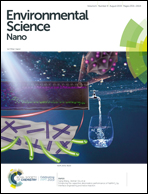Carbonaceous halloysite nanotubes for the stabilization of Co, Ni, Cu and Zn in river sediments†
Abstract
The remediation of heavy metal contaminated sediments has become a global consideration, especially the development of economically and environmentally efficient amendments. As a cost-effective natural mineral with nano structure, halloysite nanotubes were coated with carboxylic groups (HNTs@CRC) by a facile and green method, and the fabricated HNTs@CRC was further employed for the stabilization of Co, Ni, Cu and Zn in Maozhou River sediments. After remediation, the results showed an obvious increase in the residual fraction (F4) of the four heavy metals. Moreover, by mixing HNTs@CRC with Ca(OH)2, the metal stabilization performance was further enhanced. In comparison with the raw sediment (no amendment), the F4 percentages were increased by 8.0, 1.4, 2.4 and 1.8 times for Co, Ni, Cu and Zn, respectively. After conducting the toxicity characteristic leaching procedure (TCLP), the stabilization ratio (SR%) was calculated with a value of 98.82% for Co, 83.58% for Ni, 90.71% for Cu and 73.99% for Zn. Additionally, the metal stabilization mechanisms were discussed based on the features of HNTs@CRC and HNTs@CRC/Ca(OH)2, including adsorption, complexation, electrostatic affinity and precipitation. Therefore, by facile and green modification of natural minerals, this study proposed the favorable application of HNTs@CRC, especially HNTs@CRC/Ca(OH)2 for the remediation of heavy metal contaminated river sediments.



 Please wait while we load your content...
Please wait while we load your content...